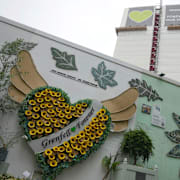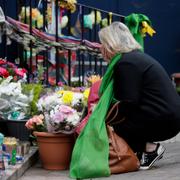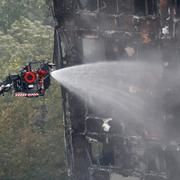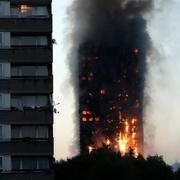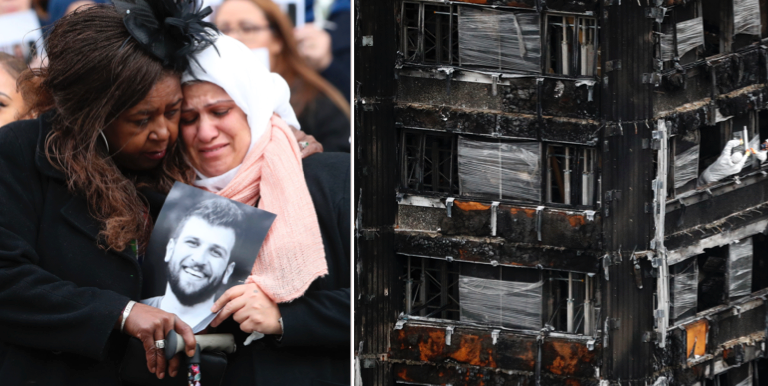
Mänskliga rättigheter kan ha brutits vid storbranden
Brittiska myndigheter har misslyckats med att lyssna på de boende, före och efter den ödesdigra höghusbranden i Grenfell Tower förra sommaren. Det säger Leilani Farha, FN:s rapportör för rätten till bostad, till The Guardian. Enligt henne kan det innebära ett brott mot de mänskliga rättigheterna.
Farha säger att hon är bekymrad över att boende i huset exkluderats från beslut om byggnadssäkerhet. De boende har också berättat att deras åsikter inte tagits till vara efter branden.
– Grunden för mänskliga rättigheter är att ha en röst, värdighet och att få delta i lösningarna av den egna situationen, säger Farha.
72 människor dog i branden som inträffade i juni förra året och hundratals blev hemlösa.
bakgrund
Branden i Grenfell Tower
Wikipedia (en)
The Grenfell Tower fire occurred on 14 June 2017 at the 24-storey Grenfell Tower block of public housing flats in North Kensington, Royal Borough of Kensington and Chelsea, West London. It caused an estimated 60 to 80 deaths and over 70 injuries. A definitive death toll is not expected before 2018. As of 19 September 2017, 60 victims had been identified by the Metropolitan Police and Coroner. Occupants for 23 of 129 flats died. Around 255 people survived. Inquests for 58 known victims were opened and adjourned at Westminster Coroner's Court.
The fire is the subject of a Public Inquiry. On 14 September 2017, the first hearing opened. Evidential hearings will start in October. Police and fire services believe the fire started accidentally in a fridge-freezer on the fourth floor. The rapid growth of the fire is thought to have been accelerated by the building's exterior cladding, which is of a common type in widespread use. An independent review of building regulations and fire safety is in progress.
Emergency services received the first report of the fire at 00:54 local time. It burned for about 60 hours until finally extinguished. More than 250 firefighters and 70 fire engines from stations all over London were involved in efforts to control the fire. Over 100 London Ambulance Service crew on at least 20 ambulances attended, joined by the specialist Hazardous Area Response Team. London's Air Ambulance sent teams of HEMS doctors and paramedics by road in support.
Firefighters rescued 65 people. Seventy-four people were confirmed by the NHS to be in six hospitals across London with 20 of them in critical care.
Many firefighters continued to fight pockets of fire on the higher floors after most of the rest of the building had been gutted. Residents of surrounding buildings were evacuated due to concerns that the tower could collapse, but the building was later determined to be structurally sound.
The Mayor of London, Sadiq Khan, criticised safety protocols, in particular those telling people to stay in their flats until rescued. This advice presumed that the building's structure could contain a fire within a single flat, but in this case the fire was spreading rapidly via the building's exterior.
Since 2013, the residents' organisation Grenfell Action Group had repeatedly expressed concern about fire safety, saying in November 2016 that only a catastrophic fire would force the block's management to adequately address fire precautions and maintenance of fire-related systems.
On 16 June 2017, Prime Minister Theresa May, who had been criticised for failing to meet Grenfell Tower residents following the tragedy, announced a £5 million fund for those affected by the fire. All those made homeless were to receive an initial down payment of £5,500, with each household to be given at least £500 in cash and £5,000 paid into an account. On 18 June the government announced that a new disaster management team was taking over, acknowledging that the initial response by the state, both locally and nationally, was inadequate. On 21 June, the government announced that 68 new flats in the local borough were to be made available to survivors.
A total of 151 homes were destroyed in the tower and surrounding area. The incident ranks as the deadliest structural fire in the United Kingdom since the start of the 20th century, when detailed records began. The death toll is higher than the Bradford City stadium fire of 1985, which killed 56 people.
Omni är politiskt obundna och oberoende. Vi strävar efter att ge fler perspektiv på nyheterna. Har du frågor eller synpunkter kring vår rapportering? Kontakta redaktionen
